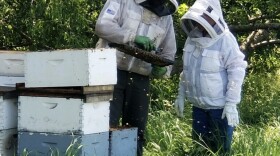Five months after its grand opening, a massive new-generation ethanol plant in the southwest corner of Kansas is undergoing final adjustments as it prepares to begin full-scale production. The plant, built by a Spanish company with financing from the U.S. Department of Energy, is designed to produce clean-burning fuel — not from corn, but from the bits and pieces of crops left in farmers’ fields after harvest.
U.S. Energy Secretary Ernest Moniz was on hand in October to launch the ceremonial start-up of the new plant near Hugoton. Following a countdown, he pushed a button and an alarm bell rang as a conveyor belt began to load bales of crop residue into the automated processing facility.
This occasion was seven years in the making. That’s how long it’s been since Abengoa, the Spanish renewable energy giant, broke ground on the gleaming complex of stainless-steel tanks, towers and pipes.
Despite all the fanfare, getting production up to speed has taken a lot longer than many people expected. Abengoa Executive Vice President Christopher Standlee said it will still be a few more weeks before the plant is producing ethanol on a commercial scale.
With the boiler up and running, the plant has produced electricity, yeast and sugar from cellulose — the material that forms the cell wall in green plants. But the company keeps starting and stopping the process to make adjustments so Abengoa can be sure it’s at maximum efficiency when it goes into full-scale production.
During a tour of the facility, chemical engineer Kevin Gross explained that the ethanol produced here essentially will be the same as that produced using corn.
“But what makes it different than any other ethanol facility is that we’re not using corn as the feedstock,” he said. “We’re using waste material, or byproducts of corn. We’re using corn stover, wheat straw, switchgrass. Any herbaceous material, we can process, and we can turn it into ethanol.”
And Moniz said there’s an abundance of biomass available in the United States for ethanol production.
“The Oak Ridge National Laboratory, one of the DOE laboratories, has estimated that, nationally, we will probably have on the order of a billion tons of biomass usable for conversion,” he said.
Most of the crop residue available for use in the Hugoton facility comes from corn grown nearby to feed livestock. And growing corn requires lots of water — water that comes from the dwindling Ogallala aquifer that underlies much of western Kansas.
But that’s not the only sustainability issue. One that’s often overlooked is the importance of crop residue to the land itself.
DeAnn Presley, an environmental soil scientist at Kansas State University, said crop residue helps prevent soil erosion and minimizes water loss.
“Anytime we have less than 80 percent of the soil surface covered, we lose water from the sun and wind, working to evaporate water,” Presley said.
So how much residue is too much to take from the soil? According to a leading expert, Ohio State University professor Rattan Lal, 70 to 80 percent of crop residue needs to be retained as a general rule.
“I did an experiment taking away the crop residue in Africa,” Lal said. “Over a 17-year period, the soil from which I was taking away all of the crop residue, it had become very hard, very cemented, very compacted. The roots could not grow through it.”

Lal said crop residue feeds the earthworms and microbes that the soil needs to grow healthy plants.
Farmers like Steve Rome understand that. He farms about 12,000 acres — mostly irrigated — around Hugoton. While Abengoa was celebrating the plant’s grand opening, Rome was on his tractor, tilling the remains of last fall’s corn crop back into a field to prepare it for planting wheat.
Rome sells some of his crop residue to Abengoa. But not from this field, where the soil is too sandy and prone to erosion. Rome considers proper land management to be more important than the money he could get by selling the corn stubble from this field.
“We look at this as a factory, and if it’s going to decrease our production levels, we won’t do it long-term,” he said. “That was an understanding when we talked to Abengoa from the very beginning. And there’s plenty of flexibility within the contract that allows us to change fields — which ones we take residue off of, and how much we need.”
Abengoa’s Christopher Standlee doesn’t think excessive removal of crop residue will become an issue. More than 15 million tons of the stuff is available within 50 miles of the plant every year.
“Of that 15.3 million tons, we only need the 0.3, roughly 320,000 tons, to operate this facility — to produce all of the electricity that we need, all of the steam that we need and the ethanol, and have some electricity left over to sell back to the grid,” he said.
And for now, there is strong demand for the 25 million gallons of ethanol the Hugoton plant can produce every year. That’s largely because of federal guidelines that require ethanol to be blended into the nation’s fuel supply. But a bill to repeal those guidelines is once again pending in the Senate.
The nonprofit KHI News Service is an editorially independent initiative of the Kansas Health Institute and a partner in the Heartland Health Monitor reporting collaboration. All stories and photos may be republished at no cost with proper attribution and a link back to KHI.org when a story is reposted online.







